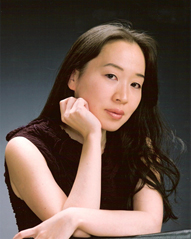Weill Recital Hall at Carnegie Hall, New York, NY
April 28, 2010

Hiroko Sasaki
One of this writer’s fondest memories was the distinguished debut of a young Japanese-born pianist, Hiroko Sasaki, on May 8, 2003 (my review of that Weill Hall concert appeared in volume 10, No. 3 of this journal). Ms. Sasaki has continued to confirm my initial impression that she was “a true artist at work.” She sounded as splendid as ever at one of her return appearances under the auspices of the Abby Whiteside Foundation’s series on April 20th in the same venue. Indeed, the pianist’s program of both books of Debussy’s Preludes consolidated that same concert of seven years ago that had included works of Haydn, Chopin and the first volume of the Debussy (even the encore, Le Petit Berger, that I had called a perfect ending the first time, was repeated).
Ms. Sasaki, who left her native Japan at age 13 to join the Yehudi Menuhin School, and subsequently earned her degree at The Curtis Institute (at 16), made her orchestral debut with the Philharmonia Orchestra and has concertized extensively in the US and Canada as recitalist and chamber musician. She is still residing in New York City and is on the faculty of the Bard College Conservatory of Music.
As I vividly recall, Ms. Sasaki’s distinctive interpretative persona successfully fuses Classical understatement with Romantic freedom. Her elegance has exquisite proportion but always (as I previously wrote) “sprint, gravitas and repose.” Danseuses de Delphes, which can often sound square and blocky, had a tart mobility which the pianist skillfully achieved by playing the answering response phrases a trifle faster and more impetuously than the forgoing ones. Her tempos, most of them on the brisk side, brought to the fore countless other felicities (I especially liked her ongoing, Gieseking-like treatment of THE eponymous interruption in Le Serenade Interrompue; and the way she managed the buildup in La Cathedrale engloutie (in accordance with Debussy’s own piano roll performance. As I remember, the two final Book I Preludes, La danse de Puck and Minstrels, were as fleet and invigorating as ever.
Book II, written a few years after Book I (1909-1910), has many similarities, but there are subtle differences, too. Ms. Sasaki, as one would have expected from such a discriminating musician, seized upon many opportunities. I loved her magnificently robust account of La Puerta de vino, and of course the Hommage a S. Pickwick, Esq. PPMPC had full, requisite Dickensian pomposity. Les Fees danced exquisitely, and Ondine was perceptively more dangerous. The culminating Feux d’artifice, with its final echo of the Marseillaise sizzled brilliantly.
All in all, a wonderful concert from beginning to end.
